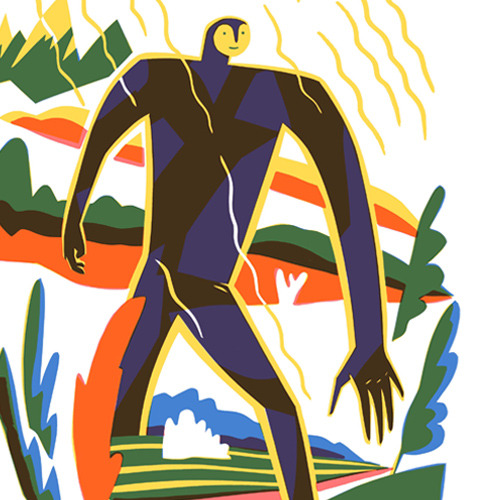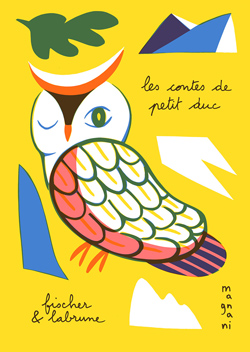< Back to posts
Jérémie Fischer & Jean-Baptiste Labrune
France

Jérémie Fischer is an illustrator and picturebook maker who graduated from the School of Decorative Arts in Strasbourg. Jean-Baptiste Labrune is a translator and author of children’s books and novels. Jérémie and Jean-Baptiste have made three books together and they founded the literary and comic strip magazine ‘Pan’.
In this post, Jérémie and Jean-Baptiste talk about the creation of the excellent ‘Les contes de petit duc’ (Little Duke’s Tales), their latest book together with French publisher Éditions Magnani.
Visit Jérémie Fischer’s website
Visit Jean-Baptiste Labrune’s website
Jérémie: ‘Les contes de petit duc’ (Little Duke’s Tales) is the third book that Jean-Baptiste Labrune and I have published together with Éditions Magnani, after ‘L’éléphouris’ (The Elemouse) in 2012 and ‘Le veilleur de nuit’ (The Night Watchman) in 2014.
It’s an illustrated book like ‘The Night Watchman’ (similar formats and both about 200 pages). But this time, the book is structured around four origin stories and a prologue and epilogue. ‘The Night Watchman’, you might know, has 7 chapters: 6 nights and 1 morning of a single week.
JB, what made you want to use a fairy-tale structure for this new book? What is your relationship with tales (this is a narrative form you used in your first book,‘The Elemouse’)?
Jean-Baptiste: It’s hard for me to say exactly how the structure of a long-form piece of writing takes shape. I go by trial and error, blindly, no plan. Then a narrative appears, I work with it, I think it’s done. Then I come back to it, and it’s all wrong. I carry on, for better or worse and a new structure emerges, sharper, subtler. The coming and going between writing and structuring can happen five, six times. Maybe more. It’s as if the text already exists, but it needs to be drawn out of me, bit by bit, little by little.
Regarding Little Duke, I remember having written some tales in 2011 – or more like poems in a very neat Baroque style. The ancestor of Little Duke featured in these. He didn’t have a name (not that name, anyhow), it was a kind of monster with three pairs of eyes rolling all over the place, who lived in a very scary forest. Then the character of an old wanderer (who became Chèms, the other main character in ‘Little Duke’s Tales’) quickly took form. I gradually realised that what interested me wasn’t the fantasy or the lexical complexity (I was entering a phase where, after ‘The Night Watchman’, I was looking to refine my language and aim more for concision), but these two characters and their relationship.
So I set to work on the two accomplices. I worked out what they had in common, what they didn’t, the images and themes associated with them. That’s how Chèms and Little Duke got their own names. Their traits were honed to become complementary to one another. I wanted a lively style, punchy, with something prophetic to it. So I dived into sacred texts, those of Miguel Angel Asturias, Khalil Gibran’s poetry, Serge Pey… and I wrote ‘Little Duke’s Tales’. The framework was in place: Little Duke would have to tell stories to Chèms.
The idea for origin stories set in quickly. In fact, I seem to have written the first story more or less straight after the prologue. I returned to a long-term reading obsession of mine (already explored in ‘The Elemouse’): Egyptian, Greek and Scandinavian mythologies, which I’ve loved since I was little, and then the authors I read later: Cyrano de Bergerac, Swift, Kipling, Tolkien and Michaux. The origin story gives a very simple temporal narrative structure (one time, one day, since this day). From there, one has total freedom; geography, characters, images, languages, everything can be re-imagined. At the same time, the rigid time frame of the origin story also allows for a social or cultural critique. It’s about requestioning the world as we know it, just seeing it as a simple contingency.
Next, with the tales, it’s possible to work on them serially, like in ‘One Thousand and One Nights’. I had my narrative, so it would be enough to make a coherent collection (or so I thought), to just put the stories one after the other. But very quickly, I found myself with so many tales – long endless lists of “why?” – and it wasn’t going anywhere. The world I had built was faint, blurry, tired. Little Duke and Chèms were buried under an abundance of stories; they weren’t characters any more, just a slightly useless narrative trick.
So I decided to settle on four stories, which are based around light and darkness, waking and sleeping, the passage of time. At the same time I established how the relationship between Little Duke and Chèms would evolve as their dialogue continued. The structure was in place. I wrote the second tale. And then the third and the fourth, and finally the epilogue. After that, it needed adjusting, editing, tightening up. Then I had to think about the text with images: remove repetition, adapt the ellipsis … There Jérémie’s work became essential, but that’s another story!
Jérémie: I went through many successive stages with illustrating the stories. Starting with trying out many different possible relationships between image and text, I wanted, at first, to work with a written manuscript and few images. In 2013, we had published our first story ‘Why is night black?’ in the first issue of a magazine called Pan, which JB and I looked after and which was edited by Julien Magnani. That was the early stages of the book, with a few ink images to go with the text.
But I wasn’t satisfied. I found the result too sensible; the text and images spoke to each other, but everything stayed in its place. Some years passed; I let the project mature in a drawer, taking it out regularly to work on breaking down the text and the book as a whole.
In 2017, something clicked. I was especially interested in Czech illustrators like Josef Čapek, Květa Pacovská and more recently Jiří Šalamoun. Also Kurt Schwitter’s two books, ‘Fairy Tales of Paris’ and ‘The Scarecrow’ (Die Scheuche Märchen), published in 1924 and 1925 respectively. I was fascinated by the freedom of colour and composition used in these different books – like how Čapek used typography as illustration on many of the book covers he produced.
At the same time, Jean-Baptiste had just written a funny little story, ‘Bululú’, very like Schwitters’ stories. I immediately got hold of it and it was published as a special edition with Pan in 2017 – a small 16-page format, 180 copies printed. From a graphic point of view, ‘Bululú’ is the prelude to ‘Little Duke’s Tales’. You see here the choice to use typography as illustration, to play with it on each page in a new way.
One year later, in July 2018, ‘Little Duke’s Tales’ was finished.
I chose the same printing technique for this book as with ‘The Night Watchman’. That is working with colours separately whilst drawing on carbon copies and using inactinic paper, constructing the image with successive sheets. We used 4 spot colours for the whole of the book.
Illustrations © Jérémie Fischer. Post translated by Gengo and edited by dPICTUS.
Les contes de petit duc /
Little Duke’s Tales
Jean-Baptiste Labrune & Jérémie Fischer
Éditions Magnani, France, 2018
Chèms sees and hears everything. He is a wise man. But Chèms starts to wonder about the reality of his wisdom. One night, Chèms meets an owl called Little Duke, who claims to know the answers to all questions.
Chèms asks Little Duke the questions he’d always pondered: Why is the night black? Why does the moon shine? Why do we dream? Why do we age? Little Duke answers Chèms’ questions in the form of tales, beginning with the tale of the giant Aketopiou, to tell the origins of the day and the night…















